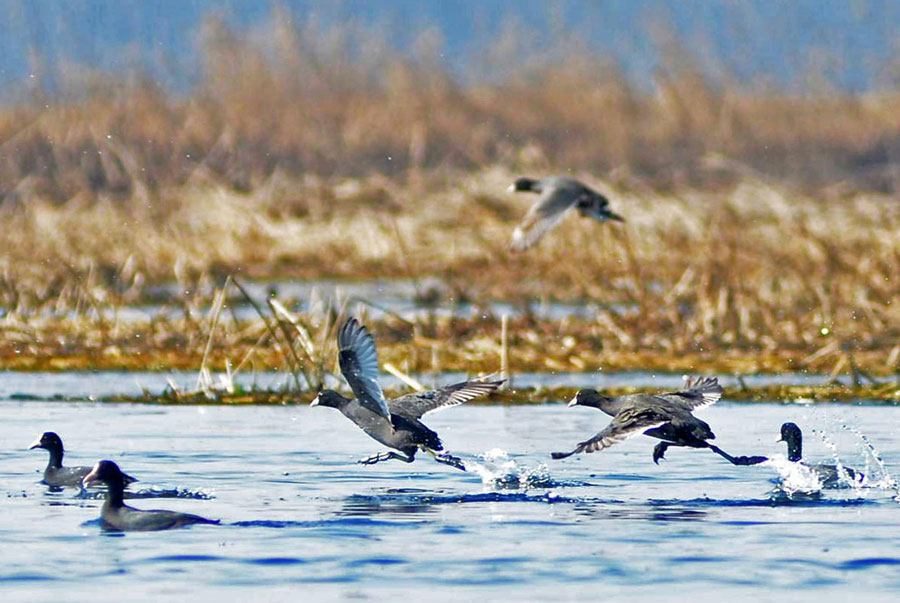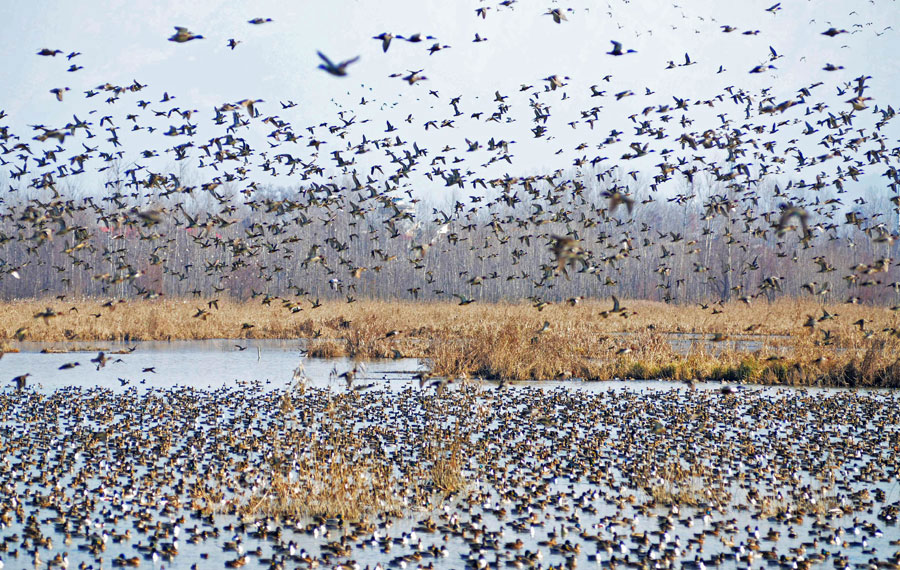Though the project is in its final stage of implementation to reduce the de-siltation, the famous Hokersar wetland requires immediate attention in preventing the encroachment and reducing the pollution load, Zainab Shafiq reports

Home to varied flora and fauna, nature has provided Kashmir with diverse ecosystems to sustain this life. One of the most important ecosystems of this valley are wetlands – peculiar ecosystems where water covers the soil, or is present either at or near the surface of the soil for the whole year or for varying periods of time during the year, including during the growing season. Kashmir boasts about such multiple addresses, one among them being the Hokersar wetland, Queen of Wetlands, 14 kms north of Srinagar.
Spread over an area of 13.75 square kilometres, including lake and marshy area, Hokersar has been historically famous because of its accessibility to Srinagar. It has remained very active, thanks to the frequent hunting sojourns by the powerful and mighty. It was one such duck-hunting session involving Mansoor Ali Khan and Sharmila Tagore in 1995 that marked the end of the bird hunting sport in Kashmir.
Hokersar is the main destination for millions of migratory birds. Tens of thousands of different species of birds, including ducks and geese like tufted duck and graylag goose visit this wetland every year. Most of these birds move temporarily from various central Asian destinations and Siberia to breed here, which makes this ‘protected’ site very important.
“Hokersar is like an airport for these birds,” says Ghulam Hassan Dar, the in charge of anti-poaching at the wetland. “The arrival of birds starts from September and they start leaving once the temperature improves.” According to the last census, conducted on January 29, the wetland had a million guests. On the census day, locals volunteer to help count the birds. This, Dar believes, spreads awareness and helps people understand the importance of these birds.
Experts say that bird migration is vital to the eco-system as it plays a vital role in nutrient cycling, seed dispersion and flower pollination.
But these birds are falling prey to human interventions, especially hunting. Smart estimation by informed people says that almost 60 birds are killed every day in wetlands across Kashmir.
“We have only 40 people to guard the wetland,” says Abdul Rauf Zargar, Wildlife Warden at Hokersar wetland. “There are no means or special equipment to track the birds. It is extremely difficult to manage; nevertheless we are trying to take appropriate measures.”
Almost all the destinations of the migratory birds are notified protected areas for better conservation, management and sustainable use under the Ramsar Convention of 1971, Indian Wild Life (Protection) Act, 1972 and J&K State Wild Life (Protection) Act, 1978. Under these laws, poaching of birds or animals is an offence, defying which the violator can face imprisonment. “If a person is caught, his gun is snatched and license seized and a case is filed in the court,” Dar said. Added vigilance, he said, has reduced poaching in comparison to earlier years.
Nisar Ahmad Parray, Senior Scientific Officer at Kashmir University says that foreign aids are provided to the NGOs to keep poaching in check.
The wetland’s significance as a flood absorption basin is well recognised. In the devastating floods of September 2014, officials said, Hokersar retained almost 2.7 million cubic meters of water and prevented the adjoining areas from further damage.
But over the years, gradual siltation, steady encroachment and increasing pollution have turned it into a ‘critical wetland’. Its effective area stands reduced to 5-6 square kilometres.
Under the Grow-More-Food Campaign (1943 to 1951), targeted for increased agricultural production, open source information suggests, large portion of the wetlands’ dry areas were encroached upon. The focus, however, was on barren lands. Documented details suggest Hokersar lost around 2031 kanals and 13 marlas since 1947. It was illegally occupied by the people living around.
“Cases against these people have been lodged in police stations, but no action has been taken so far,” Zargar said.
In its August 2017 landmark decision, the High Court directed the government to demarcate the wetlands and take measures to conserve water bodies in the Valley. The concerned bureaucracy was asked to submit action plans regarding building interconnections between wetlands and rivers.
Stressing upon the importance of demarcating wetlands, Zargar said the restoration of the Hokersar wetland requires to be managed on short-term and long-term interventions, with coordinated efforts from Wildlife Department, Forest Department and Revenue Department. Under the Settlement of Rights (section 17-24 of the JK Wildlife Protection Act), different procedures are to be adopted by the collector of an area to mark the protected areas, he added.
The wetland is facing a serious problem of siltation. Over the years, its depth has reduced from 3-10 feet to 1.5-3 feet. Managers attribute the crisis to Doodh Ganga Nallah and the Flood Spill Channel which bring all kinds of weeds and junk and dump that in the wetland.

“This is a chronic problem as de-siltation is manual and requires a lot of manpower,” Zargar said. However, a project in coordination with the Irrigation and Flood Control Department has been launched which is aimed at de-silting and dredging, along with the removal of encroachments from the wetland, he added.
“We are implementing the project, which involves de-silting an area of five kilometres of the Flood Spill Channel, from Shareefabad to Souzeth,” Farooq Ahmad Shah, Secretary Irrigation and Flood Control, said. “It was originally supposed to be a project of Rs 32 crore, but fresh tendering reduced it to Rs 21 crore and I believe it will be ready by March.” Under the contract, the company is supposed to drive the entire silt 2.5 kilometres away from the wetland.
Siltation also increases pollution load which adversely affects the aquatic life in the wetland, and causes eutrophication (excess of dissolved nutrients that stimulate the growth of aquatic plant life, usually leading to oxygen depletion) which eventually leads to a decline in the number of fishes. Besides, it also results in weed infestation which impacts the growth of hydrophytic plants; and migratory birds feed on these plants.
“One of the attracting aspects of the waterfowl ecology is the macrophytic (aquatic) vegetation as a breeding ground for the birds,” Dr Samiullah Bhat, an environmentalist, said. There are some people who are working on the waterfowls and macrophytic importance of the wetland.
Researcher Manzoor Ahmad says that in addition to helping in the purification of the water and carbon sequestration, a process by which carbon dioxide is removed from the atmosphere and held in solid or liquid form, wetlands also provide a livelihood for the locals.
But with the rapid shrinking of wetlands, this support system of the local populace is also getting wiped out.
Dar said when the Department had tried to fence the 13.75 sq km area recently, it faced public outcry. “People said it was public property and cannot be fenced.”














